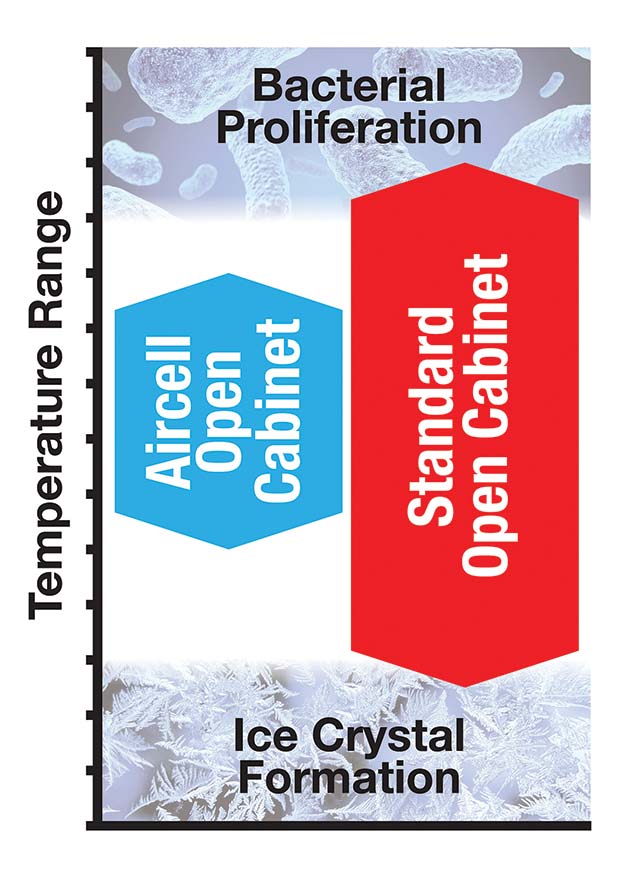Dr Catarina Marques is Research & Development Manager at Lowestoft based Adande® Refrigeration and is also a Knowledge Transfer Partnership Associate at London South Bank University. She is a graduate in Food Science and Engineering at the Polytechnic of Coimbra in her native Portugal. Catarina has recently presented a paper on minimising food moisture loss in professional cabinets at the 24th IIR International Congress of Refrigeration in Yokohama, Japan. The congress also held a debate on the cold chain, food quality and food safety. Catarina examines the issues relating to the refrigerated display of food to go in the grocery sector.

Sustained growth in the chilled snacking market, together with consumer appetite for increasingly varied and exotic food to go, has led to a much broader offer from supermarkets, convenience retailers and forecourt outlets. A typical retail refrigerated snack cabinet will now display a wide range of sandwiches, wraps, savoury pastries, pasta dishes, salads and even sushi. Many of these snacks contain high risk ingredients, such as pork, poultry, fish and salad. Invariably, these foodstuffs will not be re-heated prior to consumption, meaning that storage and display at the correct temperature is critical to food safety and quality. Nobody wants to eat a salmon sandwich or sushi, which has been stored at too high a temperature and is liable to the proliferation of harmful bacteria and toxins. At the other end of the scale, a salad or pasta dish, in which ice crystals have formed will be equally unpalatable.
EC Regulation 852/2004 and The Food Safety and Hygiene (England) Regulations 2013 state that foods likely to support the growth of pathogenic micro-organisms or the formation of toxins should be held at or below +8°C. Some authorities, including the Australian Victoria State Government, advocate that the maximum storage temperature for high risk foodstuffs should be lower at +5°C. The majority of refrigeration equipment manufacturers and grocery retailers accept an operating temperature range of -1°C to +7°C (M2) as safe and suitable for the display of chilled snacks, but to eliminate the potential for ice crystal formation it is preferable to avoid sub-zero temperatures. However, research in the foodservice sector, including trials at Westminster Kingsway College, has demonstrated that food held at a tighter and more stable temperature range will stay fresh for longer periods. In terms of the retail snacking market, this translates to a more enjoyable product for the customer and less merchandise price discounted or thrown away due to deterioration in quality or appearance. To compound the issue we are also aware that some snack food refrigerated cabinets on the market did not achieve the appropriate M2 operating temperature range of -1°C to +7°C.
 To establish the facts, Adande® commissioned independent like-for-like tests to compare the temperature range of a standard open front multi deck refrigerated cabinet with that of a similar case modified with the Adande® Aircell® air flow management system. The trials were carried out under BS EN ISO 23953, which is the accepted industry standard for the testing of refrigerated display cases, at ECH Engineering’s state-of-the-art laboratories near Bristol. After stable state running for 24 hours, the temperatures of product packs in each case were monitored over a further 24 hour cycle. The case modified with the prototype Aircell® system demonstrated a 40% narrower temperature range than the standard model, with no product pack readings recorded in the warm zone, which supports bacterial proliferation, and no readings in the sub-zero zone, which causes ice crystal formation. By contrast, product pack temperatures in the standard case included measurements in both the dangerous warm zone and the sub- zero zone.
To establish the facts, Adande® commissioned independent like-for-like tests to compare the temperature range of a standard open front multi deck refrigerated cabinet with that of a similar case modified with the Adande® Aircell® air flow management system. The trials were carried out under BS EN ISO 23953, which is the accepted industry standard for the testing of refrigerated display cases, at ECH Engineering’s state-of-the-art laboratories near Bristol. After stable state running for 24 hours, the temperatures of product packs in each case were monitored over a further 24 hour cycle. The case modified with the prototype Aircell® system demonstrated a 40% narrower temperature range than the standard model, with no product pack readings recorded in the warm zone, which supports bacterial proliferation, and no readings in the sub-zero zone, which causes ice crystal formation. By contrast, product pack temperatures in the standard case included measurements in both the dangerous warm zone and the sub- zero zone.
In addition to its accurate and stable temperature characteristics, Aircell® also demonstrates significant energy savings compared with conventional open front multi deck refrigerated cabinets. The high integrity of the Aircell® multiple air curtains significantly reduces cold air spillage from the cabinet, reducing energy usage by up to 30%. Because Aircell® reduces the spillage of chilled air from the cabinet, the impact of cold aisle syndrome is substantially limited for an improved environment for shoppers and staff. It also reduces retailers’ dependence on heating regimes and cold air retrieval systems.
Tel: 0844 376 0023
Email: info@adande.com




Comments are closed.